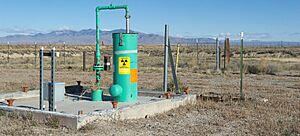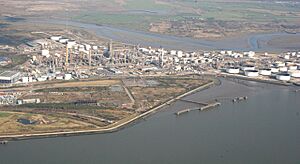Bioremediation facts for kids
Bioremediation is a clever way to clean up our environment using living things! It's a process where tiny organisms like bacteria, microalgae, fungi (in mycoremediation), and even plants (in phytoremediation) help remove harmful pollution from air, water, and soil.
These amazing organisms naturally absorb, collect, and break down pollutants. Compared to older cleaning methods, bioremediation tries to be more environmentally friendly, cheaper, and can be used on a large scale. However, it can sometimes be slow or not work perfectly.
Most of the time, bioremediation happens naturally with organisms already living in the area. Scientists are also working on ways to make it better by adding more helpful organisms or giving them nutrients to grow.
While organic pollutants can be broken down, heavy metals cannot. Instead, bioremediation can change heavy metals into less harmful forms. Bioremediation often involves changing harmful substances into simpler, less toxic ones, like turning hydrocarbons into carbon dioxide and water.
Bioremediation methods can be done in two main ways:
- In situ techniques: These clean up polluted areas right where they are.
- Ex situ techniques: These involve digging up the polluted material and treating it somewhere else.
In both methods, extra nutrients, vitamins, and minerals might be added to help the tiny organisms grow and work better. Sometimes, special groups of microbes are added, which is called biostimulation.
Some examples of bioremediation technologies include phytoremediation, bioventing, bioattenuation, biosparging, composting (like biopiles and windrows), and landfarming. The main goal of bioremediation is to remove harmful compounds to make soil and water healthier.
Contents
How Does In Situ Bioremediation Work?
In situ methods clean up pollution right where it is found, without moving the contaminated material. This can save money because there are no digging or transport costs.
Bioventing: Adding Air to Soil
Bioventing is a process that pumps air or oxygen into the soil. This helps natural microbes in the soil break down harmful substances like petroleum and other chemicals. Oxygen is usually the best choice because it helps the microbes work more efficiently.
These microbes can break down many types of hydrocarbons found in gasoline, kerosene, and jet fuel. The lighter chemicals are easier to break down quickly. Heavier chemicals are harder to remove.
In many bioremediation processes, oxygen is added to help break down pollutants. Sometimes, other substances are added to help reduce oxidized pollutants like nitrates or metals. Extra nutrients and pH balancers might also be added to create the best conditions for the microbes. Sometimes, special microbes are even added to boost the cleanup, which is called bioaugmentation.
To add oxygen deep underground, people might pump aerated water through the polluted area, add pure oxygen, or use special chemicals like hydrogen peroxide. Another method is air sparging, where air is injected under pressure below the water table.
Biostimulation: Boosting Natural Bacteria
Bioremediation can happen with bacteria that are already in the environment. In biostimulation, we help these helpful bacteria grow more by adding nutrients.
For example, to clean up oil spills in the ocean, adding nitrogen and phosphorus can help bacteria break down the oil. However, breaking down hydrocarbons can be a slow process.
Sometimes, different types of microbes work together in a team, called a microbial consortium. What one type of microbe produces, another type might use as food.
Anaerobic bioremediation (without oxygen) can also be used to treat certain pollutants like chlorinated chemicals and nitrates. This involves adding a substance that helps microbes reduce these pollutants. The choice of substance depends on the type of pollution and the area. Some substances release slowly, staying in place longer, while others spread out more quickly.
Bioattenuation: Natural Cleanup
Bioattenuation is when natural processes, including microbes, break down pollution without much human help. The microbes already living in the area do the work. Even though people aren't actively involved in the cleanup, the polluted site still needs to be watched to make sure it's working.
Biosparging: Cleaning Groundwater
Biosparging is a method used to clean groundwater. Oxygen, and sometimes nutrients, are injected into the ground. This stimulates the natural bacteria in the water to break down pollutants faster. Biosparging specifically targets polluted areas that are saturated with water, like groundwater.
Some organizations, like UNICEF, use simple and cheap bioremediation methods, such as dropping aerobic bacteria tablets into water to clean it.
How Does Ex Situ Bioremediation Work?
Ex situ techniques involve digging up the polluted material and treating it away from the original site. This can be more expensive due to the costs of digging and moving the material.
Biopiles: Piling Up Polluted Soil
Biopiles are similar to bioventing, but the polluted soil is dug up and piled into mounds. An aeration system is then used to pump air into the piles, which helps the microbes break down petroleum pollutants. This system can either push air in or pull it out to help the microbes work better.
Windrows: Turning the Soil
Windrow systems are like large compost piles. Polluted soil is regularly turned over to get more air into it. This turning also helps spread the contaminants evenly, which speeds up the bioremediation process.
Landfarming: Spreading Out Pollution
Landfarming, also called land treatment, is often used for sludge spills. This method spreads out the contaminated soil and then turns it over regularly to add air. This process is done above ground. For it to work well, the polluted soil needs to be shallow. If the pollution is deeper than about 1.5 meters (5 feet), the soil must be dug up and brought to the surface. While it's an ex situ technique, it can sometimes be done right at the site of the contamination.
Heavy Metals and Bioremediation
Heavy metals like cadmium, chromium, lead, and uranium get into our environment from factories, electronic waste, mining, and natural events like wildfires. Unlike organic pollutants, heavy metals cannot be broken down by microbes. However, bioremediation can help make these metals less mobile, meaning they are less likely to spread and harm people or the environment.
For example, some microbes can change harmful hexavalent chromium (Cr[VI]) into a less toxic and less mobile form (Cr[III]). Similarly, they can change mobile uranium (U[VI]) into less mobile uranium (U[IV]). Microbes are important for this because these changes happen very slowly without them.
Scientists are also looking into ways to use microbes to absorb metals onto their cell walls, which could help remove metals like cadmium, chromium, and lead from water. Phytoextraction processes use plants to pull contaminants into their bodies, which can then be removed.
Bioremediation isn't just for metals. After the massive Deepwater Horizon oil spill in the Gulf of Mexico in 2010, bacteria and archaea helped clean up the coast. These tiny organisms have developed ways to use oil and petroleum as food. Microbial bioremediation is a very effective modern way to clean up natural systems by removing toxins.
Pesticides and Bioremediation
Pesticides are chemicals used in farming that can contaminate soil and water. Many of these chemicals are designed to last a long time, which makes them hard to break down. They can cause health problems like cancer, rashes, and other issues. For example, Lindane, a pesticide used in the past, can harm helpful soil bacteria and cause nervous system problems in animals. Even though its use is limited now, it's still produced and used in some parts of the world.
A type of bacteria called Actinobacteria shows promise for cleaning up pesticides right in the soil. When certain types of Actinobacteria work together, they become even better at breaking down pesticides. This method could be reused and strengthened over time. However, this research is still mostly in labs, and more work is needed to see if it can be used widely and affordably.
Challenges of Bioremediation
Bioremediation is not always used to clean up pollution. Here are some reasons why:
- Heavy metals and radioactive elements usually cannot be broken down by microbes. They can sometimes be changed into less mobile forms, but not completely removed.
- Incomplete breakdown: Sometimes, microbes don't fully break down a pollutant. This can accidentally create new, even more toxic compounds. For example, when Trichloroethylene (TCE) is broken down without oxygen, it might produce dichloroethylene (DCE) and vinyl chloride (VC), which are known to cause cancer. However, a specific microbe called Dehalococcoides can break these down further into harmless ethene.
- Specific conditions needed: Microbes need very specific conditions to work well. Many environmental factors, like temperature and pH, must be just right.
- Scaling up is hard: It can be difficult to take successful results from small lab tests and apply them to large polluted areas.
- Time consuming: Bioremediation often takes much longer than other cleanup methods like burying waste in landfills or burning it (incineration). For example, bioventing is cheap but can take several years to clean a site.
- Finding the right microbes: It's hard to find the perfect type of microbe for a cleanup. They need to be native to the area (to avoid introducing harmful new species), plentiful enough to do the job, and strong enough to survive the conditions.
- Low bioavailability: For some pollutants, like pesticides in soil, it's hard for microbes to access them. Changing the soil's pH and temperature can help increase this access, leading to better breakdown.
- Limited experience: Since there's limited experience with some harmful contaminants, lab tests are often needed to figure out the best way to clean them up and how long it will take. Bioremediation can take months to several years, depending on the size of the polluted area.
Genetic Engineering and Bioremediation
Scientists are researching how to use genetic engineering to create special organisms for bioremediation. They can add genes that help organisms break down pollutants or genes that help them detect pollution levels. For example, some Pseudomonas bacteria have been changed to glow when they find a pollutant called naphthalene. A test of these modified organisms in a real environment was successful on a medium scale.
There are some worries about releasing genetically modified organisms into the environment, mainly because their genes could spread to other organisms. However, rules are in place to control this, and scientists are developing ways to make sure these modified organisms can only survive in specific conditions. They can also add genes that make the organisms glow, making them easier to track.
Genetically modified organisms have also been created to help clean up oil spills and break down certain plastics.
New Technologies: Additive Manufacturing
Additive manufacturing, like bioprinting, is a new technology that could help bioremediation. It allows scientists to create special structures designed for biological systems and environmental cleanup. While this technology is still new in bioremediation, it is growing rapidly.
See also
 In Spanish: Biorremediación para niños
In Spanish: Biorremediación para niños
- Bioremediation of radioactive waste
- Biosurfactant
- Chelation
- Dutch pollutant standards
- Folkewall
- In situ chemical oxidation
- In situ chemical reduction
- List of environment topics
- Mega Borg Oil Spill
- Microbial biodegradation
- Mycoremediation
- Mycorrhizal bioremediation
- Pleurotus
- Phytoremediation
- Pseudomonas putida (used for degrading oil)
- Restoration ecology
- Xenocatabolism




